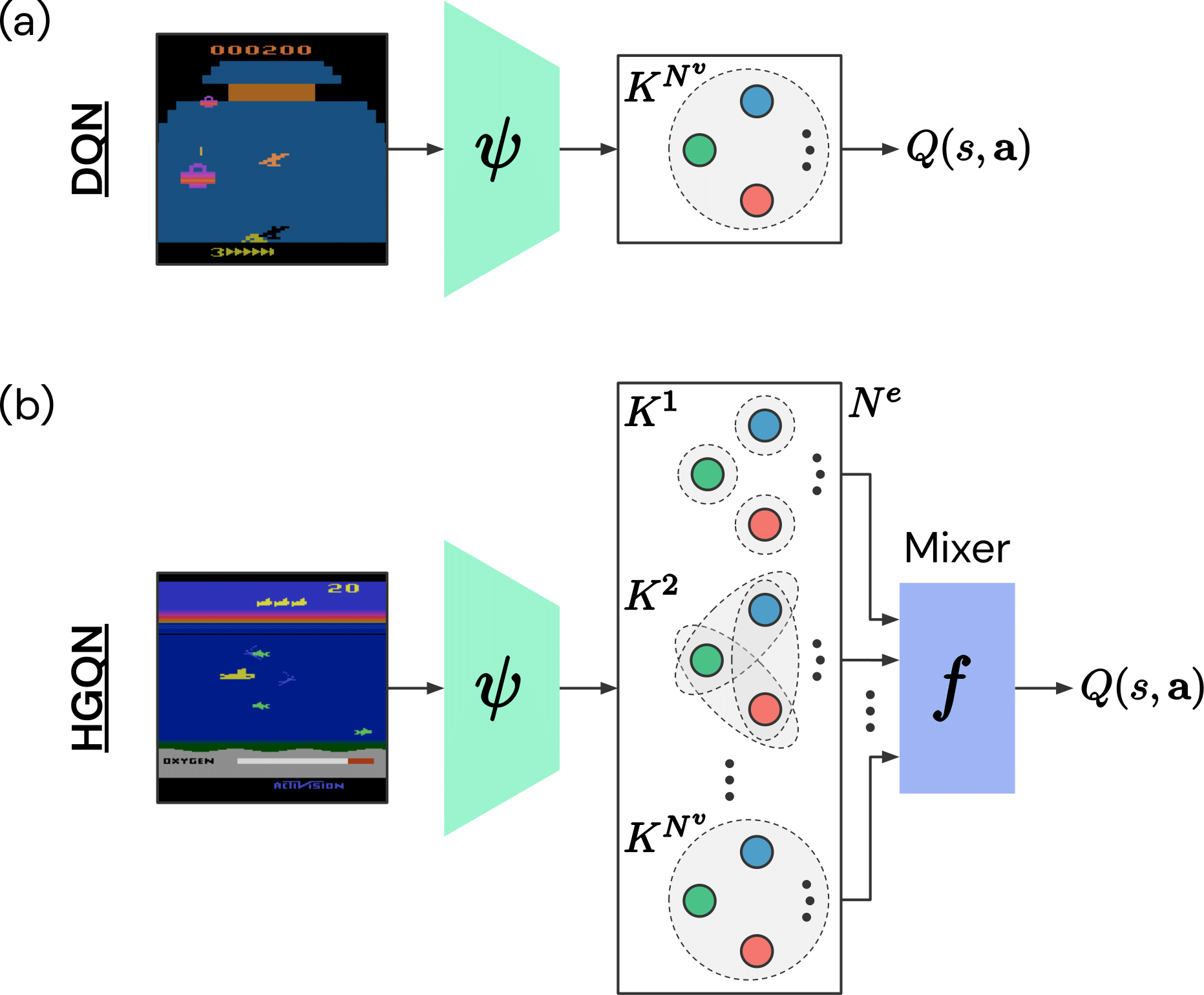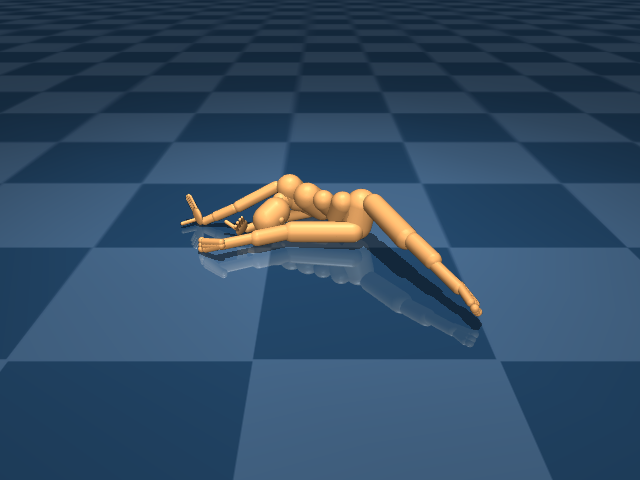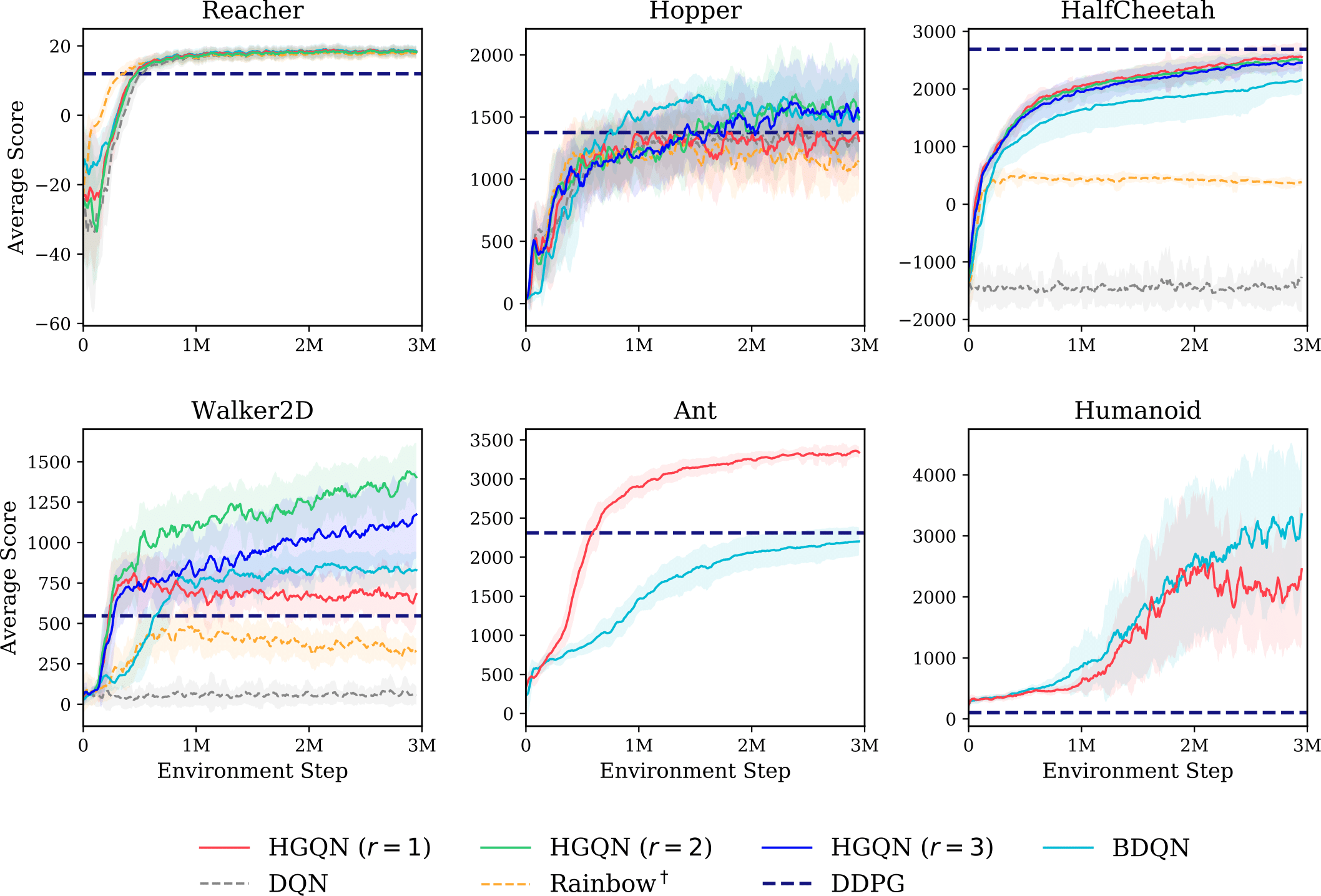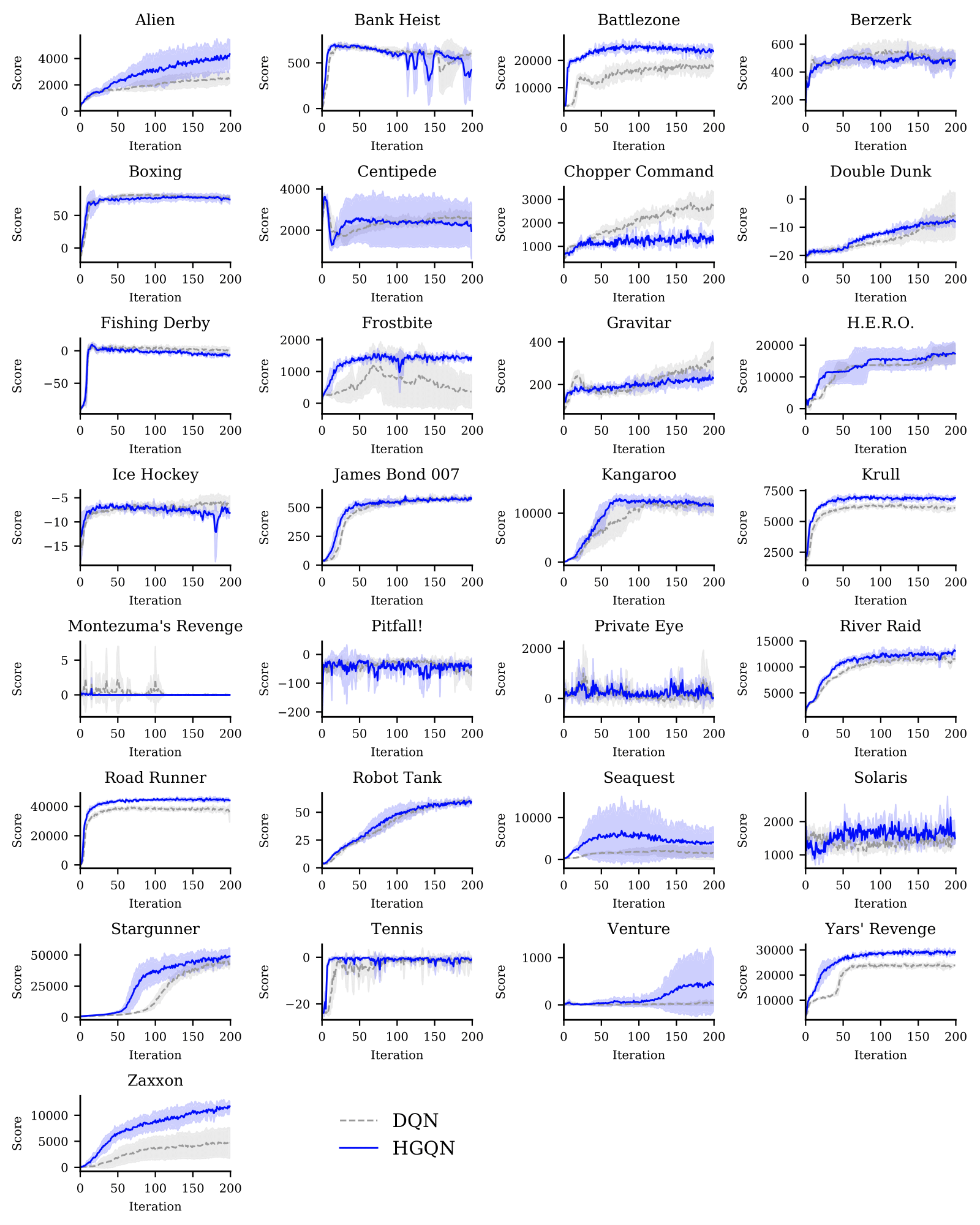Implementation of the hypergraph Q-networks (HGQN) agent in TensorFlow, built on Dopamine (Castro et al., 2018).
If you find this code useful, please cite the paper:
Tavakoli, A., Fatemi, M., and Kormushev, P. (2021). Learning to represent action values as a hypergraph on the action vertices. In Proceedings of the 9th International Conference on Learning Representations (ICLR).
In BibTeX format:
@inproceedings{tavakoli2021learning,
title={Learning to Represent Action Values as a Hypergraph on the Action Vertices},
author={Arash Tavakoli and Mehdi Fatemi and Petar Kormushev},
booktitle={International Conference on Learning Representations},
year={2021},
url={https://openreview.net/forum?id=Xv_s64FiXTv}
}
Action-value estimation is a critical component of many reinforcement learning methods whereby sample complexity relies heavily on how fast a good estimator for action value can be learned. By viewing this problem through the lens of representation learning, good representations of both state and action can facilitate action-value estimation. While advances in deep learning have seamlessly driven progress in learning state representations, given the specificity of the notion of agency to reinforcement learning, little attention has been paid to learning action representations. We conjecture that leveraging the combinatorial structure of multi-dimensional action spaces is a key ingredient for learning good representations of action. To test this, we set forth the action hypergraph networks framework - a class of functions for learning action representations in multi-dimensional discrete action spaces with a structural inductive bias. Using this framework we realise an agent class based on a combination with deep Q-networks (DQN by Mnih et al., 2015), which we dub hypergraph Q-networks (HGQN). Using this agent class, we show the effectivess of our approach on a myriad of domains: Atari 2600 games and discretised physical control benchmarks.
If you are interested to know more about HGQN or, more generally, about action hypergraph networks, consider checking the following resources:
To use the proposed agents and baselines, you need to install python3 and make sure pip is up to date. If you want to experiment with PyBullet, DeepMind Control Suite (DMC), or OpenAI Gym (MuJoCo or Box2D), you should install them separately. To do so, please check the following repositories:
- PyBullet (free, open-source): github.com/bulletphysics/bullet3
- DeepMind Control Suite: github.com/deepmind/dm_control
- OpenAI-Gym MuJoCo: github.com/openai/gym
- OpenAI-Gym Box2D (free, open-source): github.com/openai/gym
To start using this repository, follow the steps below.
1. Clone the repository:
git clone https://github.com/atavakol/action-hypergraph-networks
cd action-hypergraph-networks2. Create a virtual environment:
If you do not wish to run this code in a virtual environment, you can skip this step.
First install Anaconda which we will use as the environment manager, e.g. via:
wget https://repo.anaconda.com/archive/Anaconda3-2019.10-Linux-x86_64.sh
bash Anaconda3-2019.10-Linux-x86_64.shThen create an environment as below:
conda create --name hyperdopamine-env python=3.6
conda activate hyperdopamine-envThis will create a directory called hyperdopamine-env in which your virtual
environment lives. The last command activates the environment.
3. Setup the environment and install dependencies:
Finally setup the virtual environment and install the main dependencies via:
pip install -U pip
sudo apt-get update && sudo apt-get install cmake zlib1g-dev
pip install -e .
conda install tensorflow-gpu==1.15This codebase is compatible with Arcade Learning Environments (i.e. Atari 2600), PyBullet, DeepMind Control Suite (DMC), and OpenAI Gym (MuJoCo or Box2D) environments. Each agent in the paper (including all baselines except for DDPG) is configured by a gin file which can be used to reproduce the results in the paper, or to run the same agents in more environments. These configuration files can be modified directly or via the command-line to experiment with other environment or agent parameters. Next we outline how each agent can be run from the command-line by utilising the gin files.
Use the following to run the agents in our main Atari 2600 experiment (set agent to dqn or hgqn). For HGQN, you can modify hyperedge_orders (default is [1,2,3]; [1], [2], [1,2], [1,3], and [2,3] are also valid choices) and mixer (default is sum; universal is supported too) in the agent's gin configuration file (located hyperdopamine/agents/dqn/configs/hgqn_atari.gin) to create arbitrary action hypergraph networks for the Atari 2600 suite.
agent=hgqn # or dqn
environment=Zaxxon # needs atari-py installed
seed=0
python -um hyperdopamine.interfaces.train \
--base_dir=./logs/$environment/$agent/$seed \
--gin_files="hyperdopamine/agents/dqn/configs/${agent}_atari.gin" \
--gin_bindings="atari_lib.create_atari_environment.game_name='$environment'" \
--gin_bindings="atari_lib.create_atari_environment.environment_seed=$seed" \
--gin_bindings="Runner.agent_seed=$seed" \
--schedule=continuous_trainTo see the full list of physical control environments that are readily supported (as well as their metadata), please refer to hyperdopamine/interfaces/environment_metadata.py.
Bootstrapping from non-terminal timeout transitions can significantly improve performance in environments which have short auxiliary time limits (Pardo et al., 2018). As such, in our physical control environments which have relatively short time limits, we apply this technique to all agents.
Use the following to run HGQN in the popular physical control environments. You can modify hyperedge_orders and mixer (default is sum; universal is supported too) in hyperdopamine/agents/rainbow/configs/hgqn.gin to create arbitrary action hypergraph networks in such tasks. For example, for environment = HopperBulletEnv (with a 3-dimensional action space), setting hyperedge_orders = [1,-1] instantiates a model based on a hypergraph with all the 1-hyperedges and the single highest-order hyperedge (including [-1] captures the highest-order).
environment=BipedalWalker # needs OpenAI-Gym Box2D installed
seed=0
python -um hyperdopamine.interfaces.train \
--base_dir=./logs/$environment/hgqn-r2-sum/$seed \
--gin_files="hyperdopamine/agents/rainbow/configs/hgqn.gin" \
--gin_bindings="RainbowAgent.hyperedge_orders='[1,2]'" \
--gin_bindings="RainbowAgent.mixer='sum'" \
--gin_bindings="RainbowAgent.observation_shape=%environment_metadata.${environment^^}_OBSERVATION_SHAPE" \
--gin_bindings="create_discretised_environment.environment_name='$environment'" \
--gin_bindings="create_discretised_environment.version=%environment_metadata.${environment^^}_ENV_VER" \
--gin_bindings="create_discretised_environment.environment_seed=$seed" \
--gin_bindings="Runner.max_steps_per_episode=%environment_metadata.${environment^^}_TIMELIMIT" \
--gin_bindings="Runner.agent_seed=$seed" \
--schedule=continuous_train_and_evalAs stated in the paper, the class of rank-1 monotonic-mixer HGQN agents can gracefully scale to very high-dimensional discrete action spaces. To achieve the respective computational benefits, we release a separate implementation of this class of agents. You can modify mixing_network (default is sum_mixer; monotonic_linear_mixer and monotonic_nonlinear_mixer are supported too) to achieve different monotonic mixing strategies.
environment=AntBulletEnv # needs PyBullet installed
seed=0
python -um hyperdopamine.interfaces.train \
--base_dir=./logs/$environment/hgqn-r1-sum/$seed \
--gin_files="hyperdopamine/agents/hgqn_r1/configs/hgqn_r1.gin" \
--gin_bindings="HGQNr1Agent.mixing_network=@networks.sum_mixer" \
--gin_bindings="HGQNr1Agent.observation_shape=%environment_metadata.${environment^^}_OBSERVATION_SHAPE" \
--gin_bindings="create_discretised_environment.environment_name='$environment'" \
--gin_bindings="create_discretised_environment.version=%environment_metadata.${environment^^}_ENV_VER" \
--gin_bindings="create_discretised_environment.environment_seed=$seed" \
--gin_bindings="Runner.max_steps_per_episode=%environment_metadata.${environment^^}_TIMELIMIT" \
--gin_bindings="Runner.agent_seed=$seed" \
--gin_bindings="WrappedPrioritizedReplayBuffer.action_shape=%environment_metadata.${environment^^}_ACTION_SHAPE" \
--schedule=continuous_train_and_evalWe also release an implementation of the Branching-DQN (BDQN) agent (Tavakoli et al., 2018), which can also scale to very high-dimensional discrete action spaces just as our rank-1 monotonic-mixer HGQN agent.
environment=Humanoid # needs OpenAI-Gym MuJoCo installed
seed=0
python -um hyperdopamine.interfaces.train \
--base_dir=./logs/$environment/bdqn/$seed \
--gin_files='hyperdopamine/agents/bdqn/configs/bdqn.gin' \
--gin_bindings="BDQNAgent.observation_shape=%environment_metadata.${environment^^}_OBSERVATION_SHAPE" \
--gin_bindings="create_discretised_environment.environment_name='$environment'" \
--gin_bindings="create_discretised_environment.version=%environment_metadata.${environment^^}_ENV_VER" \
--gin_bindings="create_discretised_environment.environment_seed=$seed" \
--gin_bindings="Runner.max_steps_per_episode=%environment_metadata.${environment^^}_TIMELIMIT" \
--gin_bindings="Runner.agent_seed=$seed" \
--gin_bindings="WrappedPrioritizedReplayBuffer.action_shape=%environment_metadata.${environment^^}_ACTION_SHAPE" \
--schedule=continuous_train_and_evalTo run the DQN (Mnih et al., 2015) and simplified Rainbow (Hessel et al., 2018) baselines (as detailed in the paper) in discretised physical control environments, you can run the following snippet from the command-line (set agent to dqn or rainbow):
agent=dqn # or rainbow
environment=reacher_easy # needs DeepMind Control Suite installed
seed=0
python -um hyperdopamine.interfaces.train \
--base_dir=./logs/$environment/$agent/$seed \
--gin_files="hyperdopamine/agents/rainbow/configs/$agent.gin" \
--gin_bindings="RainbowAgent.observation_shape=%environment_metadata.${environment^^}_OBSERVATION_SHAPE" \
--gin_bindings="create_discretised_environment.environment_name='$environment'" \
--gin_bindings="create_discretised_environment.version=%environment_metadata.${environment^^}_ENV_VER" \
--gin_bindings="create_discretised_environment.environment_seed=$seed" \
--gin_bindings="Runner.max_steps_per_episode=%environment_metadata.${environment^^}_TIMELIMIT" \
--gin_bindings="Runner.agent_seed=$seed" \
--schedule=continuous_train_and_evalTo visualise the interaction process during the evaluation phase (i.e. when using Runner and not TrainRunner) simply set Runner.render = True in the configuration file or via the gin_bindings flag:
environment=humanoid_CMU_run # needs DeepMind Control Suite installed
seed=0
python -um hyperdopamine.interfaces.train \
--base_dir=./logs/$environment/hgqn-r1-sum/$seed \
--gin_files="hyperdopamine/agents/hgqn_r1/configs/hgqn_r1.gin" \
--gin_bindings="HGQNr1Agent.observation_shape=%environment_metadata.${environment^^}_OBSERVATION_SHAPE" \
--gin_bindings="create_discretised_environment.environment_name='$environment'" \
--gin_bindings="create_discretised_environment.version=%environment_metadata.${environment^^}_ENV_VER" \
--gin_bindings="create_discretised_environment.environment_seed=$seed" \
--gin_bindings="Runner.max_steps_per_episode=%environment_metadata.${environment^^}_TIMELIMIT" \
--gin_bindings="Runner.agent_seed=$seed" \
--gin_bindings="Runner.render=True" \
--gin_bindings="WrappedPrioritizedReplayBuffer.action_shape=%environment_metadata.${environment^^}_ACTION_SHAPE" \
--schedule=continuous_train_and_evalShortly after launching the code, a visualisation window pops open for a previously trained agent (i.e. if loading from a checkpoint) or for a brand-new (seemingly 'contortionist') agent:
This repository also contains the performance logs of the agents in the Atari 2600 games and physical control environments of the paper. In addition, we release unpublished results on the OpenAI-Gym's Humanoid environment and a full evaluation of our implementation of the Branching-DQN (BDQN) agent (Tavakoli et al., 2018) in the physical control environments. Run the following command to plot the full physical-control benchmark:
python plot_physical.pyTo plot the Atari 2600 benchmark, run the following command:
python plot_atari.py



